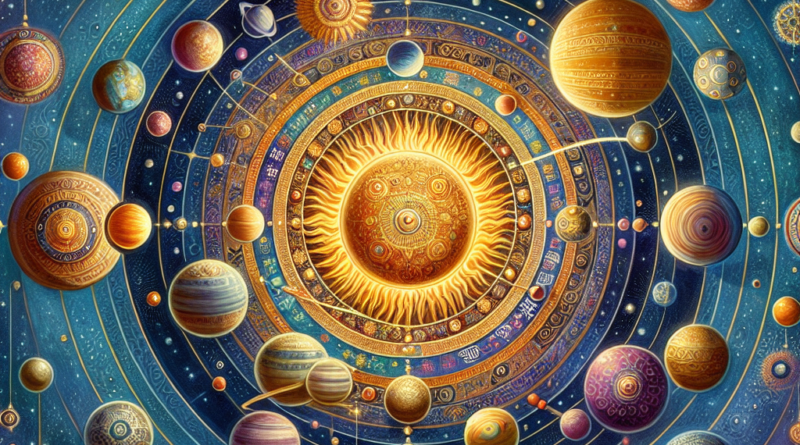Exploring the Cosmic Mysteries of Vedic Astrology
Title: Solar System in Vedic Scriptures: Hindu and Indian Cultural Significance
Introduction:
The Solar System has fascinated humanity for centuries, with its celestial bodies and the vast expanse of space sparking curiosity and wonder. In the ancient Vedic scriptures of Hinduism, the Solar System holds a significant place, with detailed descriptions of the planets and their movements. This article explores the portrayal of the Solar System in Vedic scriptures, delving into its historical context and contemporary relevance in Hindu and Indian culture.
Historical Context:
The Vedic scriptures, including the Rigveda, Yajurveda, Samaveda, and Atharvaveda, are among the oldest religious texts in the world, dating back to around 1500-1200 BCE. These texts contain hymns, rituals, and philosophical teachings that form the basis of Hinduism. The ancient seers or rishis who composed these scriptures had a deep understanding of astronomy and cosmology, as reflected in their descriptions of the Solar System.
In the Rigveda, the Sun is revered as the deity Surya, who is described as the eye of the world and the source of light and energy. The Sun’s movements and its role in sustaining life on Earth are praised in hymns dedicated to Surya. The other planets in the Solar System, such as the Moon (Chandra), Mars (Mangal), Mercury (Budha), Jupiter (Brihaspati), Venus (Shukra), and Saturn (Shani), are also mentioned in the Vedic scriptures, each associated with specific deities and cosmic energies.
The concept of the Navagrahas, or the nine celestial bodies including the Sun and the planets, is integral to Hindu astrology and Vedic rituals. Each planet is believed to influence human life and karma, and their positions in the zodiac are considered in astrological readings and horoscopes. The movement of the planets is believed to have a profound impact on individuals and the world at large, shaping destiny and spiritual growth.
Cultural Significance:
The portrayal of the Solar System in Vedic scriptures reflects the interconnectedness of the cosmos and the divine order governing the universe. Hindu cosmology envisions the universe as a vast, cyclical system of creation, preservation, and dissolution, with the planets and stars playing a crucial role in this cosmic dance. The alignment of the planets is seen as a reflection of cosmic harmony and balance, influencing human life and spiritual evolution.
In Hindu mythology, the planets are personified as deities with unique qualities and attributes. For example, Surya is worshipped as the source of light and vitality, while Chandra is associated with emotions and intuition. Each planet is linked to specific energies and virtues that individuals can cultivate through rituals, prayers, and meditation.
The festivals and rituals associated with the Navagrahas, such as Navratri and Surya Puja, are observed by millions of Hindus around the world to seek blessings and mitigate the malefic effects of planetary influences. Pilgrimages to temples dedicated to the Navagrahas are common, where devotees offer prayers and perform rituals to appease the celestial deities and seek their guidance and protection.
Contemporary Relevance:
In the modern era, the study of the Solar System continues to be a source of fascination and scientific inquiry. While the Vedic descriptions of the planets may not align with contemporary astronomical knowledge, the symbolic and spiritual significance of the Solar System in Hindu and Indian culture remains relevant.
Astrology, based on the positions of the planets at the time of one’s birth, continues to be practiced by many Hindus as a guide for personal and spiritual growth. The alignment of the planets is believed to influence one’s personality, relationships, and life path, offering insights into karmic patterns and potential challenges and opportunities.
Moreover, the reverence for the Sun and the planets in Hindu rituals and prayers reflects a deep respect for nature and the cosmic forces that sustain life on Earth. By honoring the celestial bodies and seeking their blessings, Hindus reaffirm their connection to the divine order of the universe and the eternal cycles of creation and rebirth.
In conclusion, the portrayal of the Solar System in Vedic scriptures highlights the rich cosmological and spiritual heritage of Hinduism and Indian culture. The ancient wisdom contained in these texts continues to inspire awe and reverence for the celestial bodies and their influence on human life. By exploring the Solar System through the lens of Vedic teachings, we gain a deeper appreciation for the interconnectedness of all beings and the enduring wisdom of the sages who peered into the mysteries of the cosmos.

